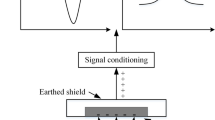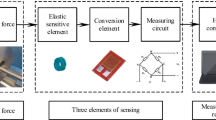Abstract
When the wafer dicing saw processes hard and brittle materials, the wear rate of the grinding wheel blade accelerates. To detect blade wear in time, a grinding wheel blade wear detection method based on a fiber optic sensor was proposed. This paper studied the principle of grinding wheel blade wear detection method, detection device, hardware system composition, and detection signal triggering process. To improve the accuracy of blade wear detection, the proportional–integral–derivative + feedforward + notch filter control algorithm was used to improve the dynamic and static response characteristics of the servo control system. This study aimed to analyze the influencing factors of the detection accuracy and efficiency of blade wear by the changing optical fiber power response mode, brightness setpoint, and signal capture detection speed. According to the experimental results, fine mode, 50% brightness setpoint, and signal capture detection speed of 0.4 mm/s were selected as the optimal parameters for blade wear detection. The performance verification experiment of the blade wear detection method was carried out under the optimized parameters. Results revealed that the maximum measurement error of the blade wear detection method was 3.8 μm. Because the measurement error could meet the industrial requirement that the measurement error of grinding wheel blade wear detection of wafer dicing saw was less than 5 μm, this method was feasible.













Similar content being viewed by others
References
Li Y, Ma X, Zhang J, Yang P, An M (2021) Research progress of metal interconnection technology and related theory in chip fabrication. Surf Technol 50:24–43+164. https://doi.org/10.16490/j.cnki.issn.1001-3660.2021.07.002
Marks MR, Cheong KY, Hassan Z (2022) A review of laser ablation and dicing of Si wafers. Precis Eng 73:377–408. https://doi.org/10.1016/j.precisioneng.2021.10.001
Huang B, Zhang Y, Wang X, Chen Y, Cao H (2021) Experimental evaluation of wear mechanism and grinding performance of SG wheel in machining nickel-based alloy GH4169. Surf Technol 50:62–70. https://doi.org/10.16490/j.cnki.issn.1001-3660.2021.12.006
Wang D, Hong R, Lin X (2021) A method for predicting hobbing tool wear based on CNC real-time monitoring data and deep learning. Precis Eng 72:847–857. https://doi.org/10.1016/j.precisioneng.2021.08.010
Wang C, Bao Z, Zhang P et al (2019) Tool wear evaluation under minimum quantity lubrication by clustering energy of acoustic emission burst signals. Meas 138:256–265. https://doi.org/10.1016/j.measurement.2019.02.004
Yu J, Cheng X, Lu L, Wu B (2021) A machine vision method for measurement of machining tool wear. Meas 182:109683. https://doi.org/10.1016/j.measurement.2021.109683
Dai Y, Zhu K (2018) A machine vision system for micro-milling tool condition monitoring. Precis Eng 52:183–191. https://doi.org/10.1016/j.precisioneng.2017.12.006
Thakre AA, Lad AV, Mala K (2019) Measurements of tool wear parameters using machine vision system. Modell Sim In Eng 2019:1–9. https://doi.org/10.1155/2019/1876489
Fong KM, Wang X, Kamaruddin S, Ismadi M-Z (2021) Investigation on universal tool wear measurement technique using image-based cross-correlation analysis. Meas 169:108489. https://doi.org/10.1016/j.measurement.2020.108489
Lins RG, de Araujo PRM, Corazzim M (2020) In-process machine vision monitoring of tool wear for cyber-physical production systems. Rbt and Comput-Integr Manuf 61:101859. https://doi.org/10.1016/j.rcim.2019.101859
Yu J, Zhou J (2020) A machine vision method for non-contact tool wear inspection. In: 2020 Chin Auto Cong (CAC). IEEE, Shanghai, China, pp 1239–1243 https://doi.org/10.1109/CAC51589.2020.9326846
Zhou J, Yu J (2021) Online measurement of machining tool wear based on machine vision. J S J T U 55:741–749. https://doi.org/10.16183/j.cnki.jsjtu.2020.083
Li Z, Liu R, Wu D (2019) Data-driven smart manufacturing: tool wear monitoring with audio signals and machine learning. J Manuf Proc 48:66–76. https://doi.org/10.1016/j.jmapro.2019.10.020
Malhotra J, Jha S (2021) Fuzzy c-means clustering based colour image segmentation for tool wear monitoring in micro-milling. Precis Eng 72:690–705. https://doi.org/10.1016/j.precisioneng.2021.07.013
Sun T, Fu Y, He L, Chen X, Zhang W, Chen W (2016) Cutting machinability for damage-tolerant titanium alloy. J S J T U 50:1017–1022. https://doi.org/10.16183/j.cnki.jsjtu.2016.07.006
Zhu K, Liu T (2018) Online Tool wear monitoring via hidden semi-Markov model with dependent durations. IEEE Trans Ind Inform 14:69–78. https://doi.org/10.1109/TII.2017.2723943
Zhou Y, Sun W (2020) Tool wear condition monitoring in milling process based on current sensors. IEEE Access 8:95491–95502. https://doi.org/10.1109/ACCESS.2020.2995586
Bhuiyan MSH, Choudhury IA, Dahari M (2014) Monitoring the tool wear, surface roughness and chip formation occurrences using multiple sensors in turning. J Manuf Syst 33:476–487. https://doi.org/10.1016/j.jmsy.2014.04.005
Gomes MC, Brito LC, Bacci da Silva M, Viana Duarte MA (2021) Tool wear monitoring in micromilling using support vector machine with vibration and sound sensors. Precis Eng 67:137–151. https://doi.org/10.1016/j.precisioneng.2020.09.025
Twardowski P, Tabaszewski M, Wiciak – Pikuła M, Felusiak-Czyryca A (2021) Identification of tool wear using acoustic emission signal and machine learning methods. Precis Eng 72:738–744. https://doi.org/10.1016/j.precisioneng.2021.07.019
Ahmad MaF, Nuawi MZ, Abdullah S et al (2015) Development of tool wear machining monitoring using novel statistical analysis method, I-kaz (TM). In: Papuga J, Ruzicka M (eds) 3rd Intl Conf on Mat and Compt P Und Var Am Ldg, Val 2015. Enl Sci Bv, Ams, pp 355–362. https://doi.org/10.1016/j.precisioneng.2021.07.019
Datta A, Dutta S, Pal SK, Sen R (2013) Progressive cutting tool wear detection from machined surface images using Voronoi tessellation method. J Mater Process Technol 213:2339–2349. https://doi.org/10.1016/j.jmatprotec.2013.07.008
Liu M-K, Tseng Y-H, Tran M-Q (2019) Tool wear monitoring and prediction based on sound signal. Int J Adv Manuf Technol 103:3361–3373. https://doi.org/10.1007/s00170-019-03686-2
He Y, Lin J, Wang Y, Li Y, Wu P (2020) In-process tool wear monitoring model based on LSTM-CNN. Chn Mech Eng 31:1959–1967. https://doi.org/10.3969/j.issn.1004-132X.2020.16.008
Li X, Liu X, Yue C et al (2021) A data-driven approach for tool wear recognition and quantitative prediction based on radar map feature fusion. Meas 185:110072. https://doi.org/10.1016/j.measurement.2021.110072
Rmili W, Ouahabi A, Serra R, Leroy R (2016) An automatic system based on vibratory analysis for cutting tool wear monitoring. Meas 77:117–123. https://doi.org/10.1016/j.measurement.2015.09.010
Dong J, Tan Z, Wang T, Wu X (2021) Tool wear prediction method combined with domain adversarial adaptation. Mech Sci Tech Aero Eng 1–8. https://doi.org/10.13433/j.cnki.1003-8728.20200614
Li T, Wu D, Khyam MO et al (2022) Recent advances and tendencies regarding fiber optic sensors for deformation measurement: a review. IEEE Sens J 22:2962–2973. https://doi.org/10.1109/JSEN.2021.3138091
He Y, Zhao Z, Liang S, Xu X, Li C, Zhang X (2021) Analysis of optical stress characteristics of inclined incident reflective optical fiber sensor. J Oe Las 32:985–991. https://doi.org/10.16136/j.joel.2021.09.0025
Li T, Guo J, Wu D, Tan Y, Zhou Z (2022) Recent advances and tendency of optical fiber sensing technology for equipment manufacturing and operating states monitoring in extreme environments. J Mech Eng 58:27–53. https://doi.org/10.3901/JME.2022.08.027
Veronesi M, Visioli A (2013) Automatic feedforward tuning for PID control loops. In: 2013 Euro Con Conf (ecc). IEEE, NYC, pp 3919–3924 https://doi.org/10.23919/ECC.2013.6669141
Piccagli S, Visioli A (2009) Minimum-time feedforward technique for PID control. IET Contr Theory Appl 3:1341–1350. https://doi.org/10.1049/iet-cta.2008.0372
Li S, Lv F (2012) Feedforward compensation based the study of PID controller. In: Jin D, Lin S (eds) Adv in E Comm, Web Appl and Comm, Vol 2. Springer-Verlag Berlin, Berlin, pp 59–64. https://doi.org/10.1007/978-3-642-28658-2_9
Nie S, Li Q, Yin F, Yang H (2019) Single neuron PID+feedforward controller of a direct drive pump system. J B J U T 45:821–830. https://doi.org/10.11936/bjutxb2018070028
Visioli A (2004) A new design for a PID plus feedforward controller. J Process Control 14:457–463. https://doi.org/10.1016/j.jprocont.2003.09.003
Jin X, Zhu S, Wu W, Luo S (2013) A novel robotic motion control strategy based on improved fuzzy PID and feedforward compensation. In: Kida K (ed) Mach Desg and Manuf Eng Ii, Pts 1 and 2. Trans Tech Pubs Ltd, Durnten-Zurich, pp 821–826. https://doi.org/10.4028/www.scientific.net/AMM.365=366.821
Jing X, Cheng L (2013) An optimal PID control algorithm for training feedforward neural networks. IEEE Trans Ind Electron 60:2273–2283. https://doi.org/10.1109/TIE.2012.2194973
Guzman JL, Hagglund T (2021) Tuning rules for feedforward control from measurable disturbances combined with PID control: a review. Int J Control. https://doi.org/10.1080/00207179.2021.1978537
Katagiri H, Kawase Y, Yamaguchi T et al (2011) Improvement of convergence characteristics for steady-state analysis of motors with simplified singularity decomposition-explicit error correction method (vol 47, pg 1458, 2011). IEEE Trans Magn 47:1786–1789. https://doi.org/10.1109/TMAG.2011.2153410
Wu J, Chen G, Chen F (2020) Positioning accuracy control of dual-axis dicing saw for machining semiconductor chip. Int J Adv Manuf Technol 109:2299–2310. https://doi.org/10.1007/s00170-020-05798-6
Funding
This work was supported by the Key Research and Development Program of Hunan Provincial (No. 2021GK2025), the National Natural Science Foundation of China (No. 51975204), and the Natural Science Foundation of Hunan Province (No. 2021JJ30103).
Author information
Authors and Affiliations
Contributions
Fengjun Chen: guidance of article research and revision of manuscripts; Jianhang Huang: conception and writing of the manuscript; Jialiang Xu: assistance of the experiment and improvement of the manuscript; Huidong Wang: data analysis and image improvement; Tian Hu: technical support and research concept.
Corresponding author
Ethics declarations
Competing interests
The authors declare no competing interests.
Additional information
Publisher's note
Springer Nature remains neutral with regard to jurisdictional claims in published maps and institutional affiliations.
Rights and permissions
Springer Nature or its licensor (e.g. a society or other partner) holds exclusive rights to this article under a publishing agreement with the author(s) or other rightsholder(s); author self-archiving of the accepted manuscript version of this article is solely governed by the terms of such publishing agreement and applicable law.
About this article
Cite this article
Chen, F., Huang, J., Xu, J. et al. Wear measurement of ultrathin grinding wheel using fiber optical sensor for high-precision wafer dicing. Int J Adv Manuf Technol 125, 2133–2145 (2023). https://doi.org/10.1007/s00170-023-10820-8
Received:
Accepted:
Published:
Issue Date:
DOI: https://doi.org/10.1007/s00170-023-10820-8




